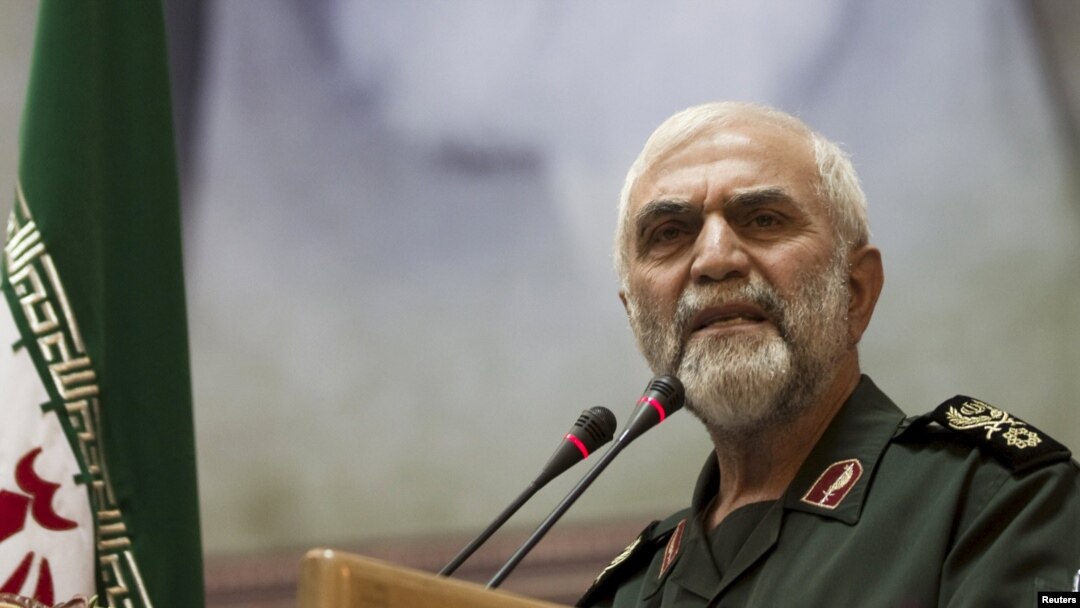Iran’s deepening investment in the struggling regime of its closest regional ally, Syria, came into further focus this week with the death of a top general in the elite Islamic Revolutionary Guards Corps (IRGC).
Hossein Hamedani was one of dozens of military advisers and other officials Tehran has sent to Damascus to help President Bashar al-Assad stay in power. According to a statement released by the IRGC, Hamedani was “martyred” on October 8 at the hands of "terrorists” of Islamic State militants on the outskirts of the northern Syrian city of Aleppo.
Hamedani had "played a determining role in the protection of the [holy Shi’a Sayeda Zeynab shrine] and helping and reinforcing the front of Islamic resistance against the terrorists,” the statement released October 9 said.
The exact circumstances of his death however were not clear from the statement.
Iranian officials refer to anti-Assad forces, including Islamic State and other rebel groups, as terrorists.
Alireza Nader, a senior Iran analyst with the Rand Corporation, told RFE/RL that Hamedani’s death shows the Iranian government is willing to risk some of its most important commanders in order to protect the Syrian regime.
“I don't doubt Tehran is willing to seek a negotiated settlement to end the Syrian conflict, but on its own terms and in the pursuit of its own interests,” Nader said. "For now, Iran has to make sure it has military leverage in Syria."
In recent months, a number of Iranians, including several IRGC members, have been killed in the fighting in Syria. Iranian media refer to them as “volunteers” who were killed while defending the Sayeda Zeynab shrine on the outskirts of Damascus. The shrine is a revered pilgrimage site for many Sh’ia Muslims, who believe it contains the remains of the daughter and granddaughter of the prophet Muhummad.
'Brave Commander'
Major General Mohammad Ali Jafari, the commander of the IRGC, a powerful paramilitary organization that also has extensive economic holdings in the Iranian economy, described Hamedani as “one of the strong pillars of the line of resistance.”
“Hamedani was ultimately martyred by the mercenaries affiliated with the U.S. and Zionists, namely the terrorists who have been armed by the hegemonic system’s allies, including Saudis, and have afflicted the Muslim people of Yemen, Iraq, Syria and Bahrain," Jafari said in a statement issued by Iranian media.
Iranian President Hassan Rohani also praised Hamedani as a “brave commander” while calling his death a “great loss” that caused “deep sorrow” in the country.
Lawmaker Ismail Kowsari said Hamedani had coordinated the efforts of the Syrian army and volunteer forces and prevented the fall of Damascus. He said Hamedani’s mission had already ended at the time of his death, and that he had returned to Syria for a few days to provide “mental help” due to his knowledge of the country.
Hamedani was a veteran of the bloody 1980-88 war with Iraq. He was also instrumental in the 2009 state crackdown against opposition members, when tens of thousands of Iranians took to Tehran’s streets to protest the disputed reelection of President Mahmud Ahmadinejad.
The protests were brutally suppressed by IRGC forces who were later accused of killing and torturing a number of the protesters. Hamedani had been blacklisted by the European Union since 2011 for his role in suppressing the protests.
Major General Hassam Firuzabadi, the chief of staff of Iran’s armed forces, praised Hamedani’s role in the 2009 unrest, calling it a “shining juncture” in his career.
“[Hamedani] did not spare any effort in defending and safeguarding the Islamic republic and its achievements,” Firuzabadi said.


